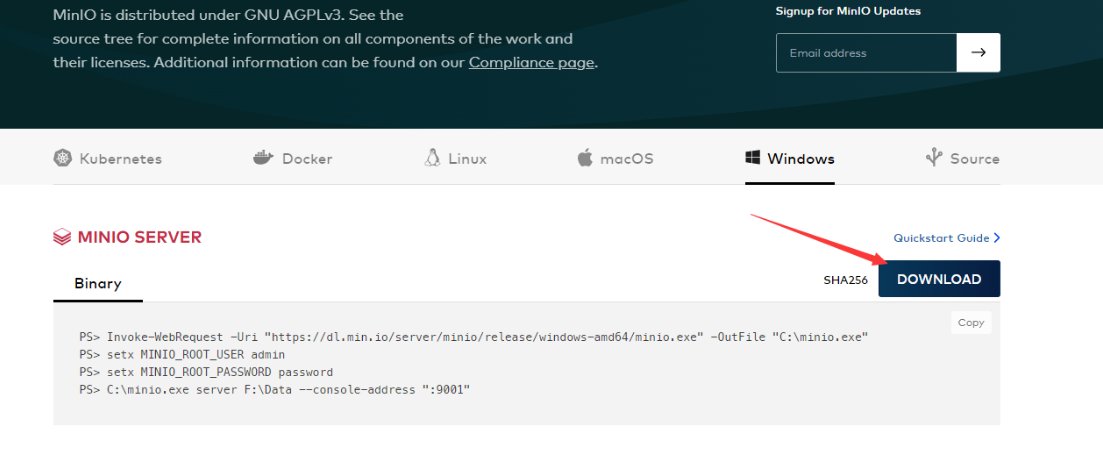springboot整合minio
代码参考
安装minio
1、进入官网:https://min.io/

我目前安装的是版本是:

在cmd窗口中,命令行进行minio.exe所在的文件夹,输入如下命令 server后面的地址是你图片上传之后的存储目录
minio.exe server E:\minio
因为这里api端口是9000,所以下面的yml需要配置9000端口
accessKey和secretKey需要根据启动的窗口上的值进行配置
bucketName这个需要自己创建
2、启动成功后,访问:127.0.0.1:9000/minio,可以进入到minio的控制台
!
用户名,密码
minioadmin
minioadmin

我们可以在控制台创建`bucketName`,当然也可以用代码创建
其实这个`bucketName`就是文件夹的意思,我们要把文件上传到哪个`bucketName`,就是要把文件上传到对应的目录下。
如果需要使用minio,他的服务一定要打开。
依赖
<!--minio-->
<dependency>
<groupId>io.minio</groupId>
<artifactId>minio</artifactId>
<version>8.0.3</version>
</dependency>
yml配置
spring:
# 配置文件上传大小限制
servlet:
multipart:
max-file-size: 200MB
max-request-size: 200MB
minio:
endpoint: http://127.0.0.1:9000
accessKey: minioadmin
secretKey: minioadmin
bucketName: test
写配置类
注册minio客户端,以便在代码中使用客户端上传文件。
@Data
@Component
public class MinIoClientConfig {
@Value("${minio.endpoint}")
private String endpoint;
@Value("${minio.accessKey}")
private String accessKey;
@Value("${minio.secretKey}")
private String secretKey;
/**
* 注入minio 客户端
* @return
*/
@Bean
public MinioClient minioClient(){
return MinioClient.builder()
.endpoint(endpoint)
.credentials(accessKey, secretKey)
.build();
}
}
工具类
实体类:
@Data
public class ObjectItem {
private String objectName;
private Long size;
}
12345
/**
* @description: minio工具类
* @version:3.0
*/
@Component
public class MinioUtilS {
@Autowired
private MinioClient minioClient;
@Value("${minio.bucketName}")
private String bucketName;
/**
* description: 判断bucket是否存在,不存在则创建
*
* @return: void
*/
public void existBucket(String name) {
try {
boolean exists = minioClient.bucketExists(BucketExistsArgs.builder().bucket(name).build());
if (!exists) {
minioClient.makeBucket(MakeBucketArgs.builder().bucket(name).build());
}
} catch (Exception e) {
e.printStackTrace();
}
}
/**
* 创建存储bucket
* @param bucketName 存储bucket名称
* @return Boolean
*/
public Boolean makeBucket(String bucketName) {
try {
minioClient.makeBucket(MakeBucketArgs.builder()
.bucket(bucketName)
.build());
} catch (Exception e) {
e.printStackTrace();
return false;
}
return true;
}
/**
* 删除存储bucket
* @param bucketName 存储bucket名称
* @return Boolean
*/
public Boolean removeBucket(String bucketName) {
try {
minioClient.removeBucket(RemoveBucketArgs.builder()
.bucket(bucketName)
.build());
} catch (Exception e) {
e.printStackTrace();
return false;
}
return true;
}
/**
* description: 上传文件
*
* @param multipartFile
* @return: java.lang.String
*/
public List<String> upload(MultipartFile[] multipartFile) {
List<String> names = new ArrayList<>(multipartFile.length);
for (MultipartFile file : multipartFile) {
String fileName = file.getOriginalFilename();
String[] split = fileName.split("\\.");
if (split.length > 1) {
fileName = split[0] + "_" + System.currentTimeMillis() + "." + split[1];
} else {
fileName = fileName + System.currentTimeMillis();
}
InputStream in = null;
try {
in = file.getInputStream();
minioClient.putObject(PutObjectArgs.builder()
.bucket(bucketName)
.object(fileName)
.stream(in, in.available(), -1)
.contentType(file.getContentType())
.build()
);
} catch (Exception e) {
e.printStackTrace();
} finally {
if (in != null) {
try {
in.close();
} catch (IOException e) {
e.printStackTrace();
}
}
}
names.add(fileName);
}
return names;
}
/**
* description: 下载文件
*
* @param fileName
* @return: org.springframework.http.ResponseEntity<byte [ ]>
*/
public ResponseEntity<byte[]> download(String fileName) {
ResponseEntity<byte[]> responseEntity = null;
InputStream in = null;
ByteArrayOutputStream out = null;
try {
in = minioClient.getObject(GetObjectArgs.builder().bucket(bucketName).object(fileName).build());
out = new ByteArrayOutputStream();
IOUtils.copy(in, out);
//封装返回值
byte[] bytes = out.toByteArray();
HttpHeaders headers = new HttpHeaders();
try {
headers.add("Content-Disposition", "attachment;filename=" + URLEncoder.encode(fileName, "UTF-8"));
} catch (UnsupportedEncodingException e) {
e.printStackTrace();
}
headers.setContentLength(bytes.length);
headers.setContentType(MediaType.APPLICATION_OCTET_STREAM);
headers.setAccessControlExposeHeaders(Arrays.asList("*"));
responseEntity = new ResponseEntity<byte[]>(bytes, headers, HttpStatus.OK);
} catch (Exception e) {
e.printStackTrace();
} finally {
try {
if (in != null) {
try {
in.close();
} catch (IOException e) {
e.printStackTrace();
}
}
if (out != null) {
out.close();
}
} catch (IOException e) {
e.printStackTrace();
}
}
return responseEntity;
}
/**
* 查看文件对象
* @param bucketName 存储bucket名称
* @return 存储bucket内文件对象信息
*/
public List<ObjectItem> listObjects(String bucketName) {
Iterable<Result<Item>> results = minioClient.listObjects(
ListObjectsArgs.builder().bucket(bucketName).build());
List<ObjectItem> objectItems = new ArrayList<>();
try {
for (Result<Item> result : results) {
Item item = result.get();
ObjectItem objectItem = new ObjectItem();
objectItem.setObjectName(item.objectName());
objectItem.setSize(item.size());
objectItems.add(objectItem);
}
} catch (Exception e) {
e.printStackTrace();
return null;
}
return objectItems;
}
/**
* 批量删除文件对象
* @param bucketName 存储bucket名称
* @param objects 对象名称集合
*/
public Iterable<Result<DeleteError>> removeObjects(String bucketName, List<String> objects) {
List<DeleteObject> dos = objects.stream().map(e -> new DeleteObject(e)).collect(Collectors.toList());
Iterable<Result<DeleteError>> results = minioClient.removeObjects(RemoveObjectsArgs.builder().bucket(bucketName).objects(dos).build());
return results;
}
}
控制器
@RestController
@Slf4j
public class MinioController {
@Autowired
private MinIoUtil minIoUtil;
@Autowired
private MinioUtilS minioUtilS;
@Value("${minio.endpoint}")
private String address;
@Value("${minio.bucketName}")
private String bucketName;
@PostMapping("/upload")
public Object upload(MultipartFile file) {
List<String> upload = minioUtilS.upload(new MultipartFile[]{file});
return address+"/"+bucketName+"/"+upload.get(0);
}
}
成功上传:
记得去控制台打开权限即可访问






【推荐】国内首个AI IDE,深度理解中文开发场景,立即下载体验Trae
【推荐】编程新体验,更懂你的AI,立即体验豆包MarsCode编程助手
【推荐】抖音旗下AI助手豆包,你的智能百科全书,全免费不限次数
【推荐】轻量又高性能的 SSH 工具 IShell:AI 加持,快人一步
· 无需6万激活码!GitHub神秘组织3小时极速复刻Manus,手把手教你使用OpenManus搭建本
· C#/.NET/.NET Core优秀项目和框架2025年2月简报
· Manus爆火,是硬核还是营销?
· 终于写完轮子一部分:tcp代理 了,记录一下
· 【杭电多校比赛记录】2025“钉耙编程”中国大学生算法设计春季联赛(1)